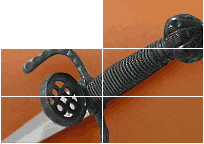Arma Bohemia Ear Dagger
Original: Italian, late 15th century/early 16th century

The medieval European ear dagger developed in the late 14th century and likely first appeared on the Iberian Peninsula before spreading into Italy and other parts of the Continent. It has a strikingly similar form to Persian Bronze Age daggers that share the characteristic discs that flare outwards from their grips to form the "ears". It was the French in the 16th century that likely coined the ear dagger terminology, calling them
dague à oreilles. The Italians merely referred to them by the appearance of their Eastern origins as
alla Levantina.
Generally speaking these daggers are defined by stout blades that expand into flaring, thick exposed tangs covered on their outside surfaces with scales of ivory, bone, horn, or even metal. Often the surfaces of the exposed tang, ricasso, and other hilt parts are ornately adorned with precious metals and are finished with advanced techniques such as enameling, incising, etching, gilding, inlaying, etc.
The dagger presented here is based on a piece located in the Museo Lázaro Galdiano, Madrid, Spain. Its grip scales are made of bone and are incised with darkened geometric patterns of lines. The bone scales are sandwiched with brass liner sheets that extend to into a foundation for the bone plaques that form the ears. Two large rounded pyramidal brass buttons rivet the ears to the tang and smaller brass rivets secure the rest of the grip.
The broad, double-edged blade is typical for the type. A thickened ricasso area transitions into an asymmetrical design with one sharpened edge being longer than the other. The antique that inspires this piece has a gilded or damascened ricasso not replicated here.
The scabbard is wood-cored and covered with black leather. Its general form with detailed metal fittings is based on a specific museum example.
Overall length: 15.25"
Weight: 15 ounces
Blade: 9" long; 1.25" wide tapering to .5"
Hilt length: 6.25"
Maker:
Arma Bohemia of the Czech Republic.

This piece is based on an example located in the Museo Lázaro Galdiano, Madrid, Spain.


